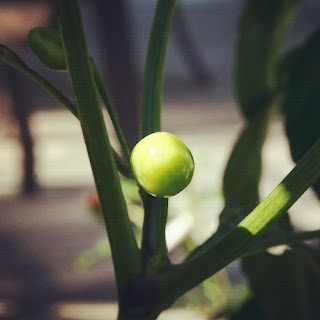 |
| Lemon Basil in the garden.... |
Southern Ontario is experiencing a wonderfully warm and steamy summer so far, which means that it's only June 23 and my garden looks like the 'after' picture from a Miracle Grow commercial. This weekend I was delightfully surprised to find that my lemon basil plant already had enough leaves to make pesto....(YAY!).
A couple of years ago, on one of my yearly trips to Florida, my aunt made this memorable Tomato Pesto Pasta with Shrimp. You know how some dishes (for whatever reason) just stick with you (this happens to me all the time)....this pasta dish was no exception. So I thought I'd take a crack at replicating it....and it turned out to be a TOTAL SUCCESS.
This recipe will give you left over pesto, which can stay in the fridge for a few weeks. It has a fresh taste (from the lemon basil) and light richness (from the roasted garlic and roasted tomatoes) that would be great with baked fish, baked chicken, as a spread on a baguette (mmmm, baguette)....etc.
 |
| Mmmmmm...pasta.... |
Lemon Basil Tomato Pesto Pasta with Shrimp
20 cloves of garlic, peeled
1/2 cup of olive oil, plus a little more for roasting tomatoes
1 pound cherry tomatoes, washed and drained
1/4 cups + 2 tablespoons pine nuts
1/4 grated Parmesan
Salt and pepper
1 cup packed lemon basil leaves, rinsed and drained (regular basil will work just as well)
1 package of brown rice spaghetti (standard package is 454g) (any pasta will work here - just modify the cooking time according to the package instructions)
1 pound large shrimp, shelled and deveined
Directions:
Pesto:
(1) Preheat oven to 375 degrees
(2) Place garlic in a single layer in a small baking dish
(3) Add 1/2 cup of olive oil to the dish, making sure all of the garlic cloves are coated
(4) Cover the baking dish with foil. Roast garlic cloves in the oven for 45 minutes until fragrant and golden brown
(5) In a medium sized baking dish, toss the cherry tomatoes with enough olive oil to lightly coat (about 2 tablespoons)
(6) Place the tomatoes in the oven (at the same temperature --- 375 degrees) and roast (uncovered) for 25 minutes
-Tomato skin should be blister-y when they are ready |
| Roasted Tomatoes... |
(7) While the garlic and tomatoes are roasting in the oven (your kitchen should smell really yummy by now), in a small fry pan on the stove, over medium heat, toast all of the pine nuts for about 15-20 minutes or until they are golden brown, turning occasionally so they don't burn…
-pine nuts should to be toasted before using. There is this thing called 'pine nut mouth' that is not dangerous, but will mess with your tastebuds for a couple of days – which is not fun... |
| Toasting pine nuts... |
(8) When the garlic is nicely roasted, remove the baking dish from the oven and remove the garlic cloves from the oil (both the garlic and the oil will be HOT so be careful). Set the garlic aside in a small bowl. Reserve the oil for use later.
 |
| Roasted garlic cloves on the bottom, garlic infused olive oil on the top... |
(9) In a food processor, blend the roasted garlic and 1/4 cup of the toasted pine nuts until creamy
(10) Add the roasted tomatoes to the food processor (not including the olive oil from the dish the tomatoes were roasted in – this will make your pesto too liquidy) and lemon basil leaves. Blend until smooth.
(11) Add the Parmesan. Blend until smooth.
-while the food processor is running, add 1-2 tablespoons of the garlic infused olive oil. This helps to bring everything together and enhances the garlic flavour.
(12) Your pesto should be the consistency of a paste now. Season for salt.
 |
| Lemon Basil Tomato Pesto.... |
Note: you will have leftover pesto.
Pasta:
(13) In a large pot of boiling salted water, cook pasta, stirring occasionally, until almost tender, about 8-10 minutes
-I find that brown rice pasta is super starchy. When water is super starchy, pasta will stick together - so make sure you are using a big enough pot with plenty of salted water to assist with constantly moving the starch away from the pasta surface.
-Salt your water people. Adding salt now will reduce the amount of salt/cheese/butter you will have to add later.
(14) Reserve about a 1/2 cup of the pasta water prior to draining the cooked pasta
-this will be used to aid in the when tossing the pasta with the rest of ingredients later....
Shrimp: (can be done while pasta is cooking)
(15) In a small fry pan over medium-high heat, add 2 tablespoons of the garlic infused oil
(16) Season the shrimp with pepper and sauté until the shrimp turn pink (about 5-6 minutes....don't overcook - rubbery shrimp is never good...)
(17) Remove from heat
(18) In a large bowl, add the cooked pasta, and some of the pesto (I usually put 3-4 heaping spoonfuls - about a 1/4 of the total amount of pesto that this recipe makes). Toss to coat the pasta with pesto. If needed, add a bit of the pasta water to make tossing easier.
(19) Add the shrimp and lightly toss just to coat the shrimp.
(20) Season for salt and pepper
(21) Garnish with the 2 tablespoons of leftover toasted pine nuts.
Optional - serve with chilli flakes and lemon wedges on the side
Nutritional Information (for one serving - 1/5 of the final product):
Calories 583
Fat 19g
Carbs 76g
Fibre 5g
Protein 27g
WW Points 15
Happy Cooking!


































